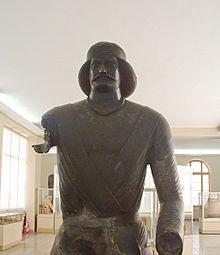
Back Art de l'Imperi Part Catalan Parthische Kunst German Arte parto Spanish هنر اشکانیان Persian Seni rupa Partia ID Arte partica Italian


Parthian art was Iranian art made during the Parthian Empire from 247 BC to 224 AD, based in the Near East. It has a mixture of Persian and Hellenistic influences. For some time after the period of the Parthian Empire, art in its styles continued for some time. A typical feature of Parthian art is the frontality of the people shown. Even in narrative representations, the actors do not look at the object of their action, but at the viewer. These are features that anticipate the art of medieval Europe and Byzantium.
Parthian sites are often overlooked in excavations, thus the state of research knowledge in Parthian art is not complete. The excavations at Dura-Europos in the 20th century provided many new discoveries. The classical archaeologist and director of the excavations, Michael Rostovtzeff, realized that the art of the first centuries AD from Palmyra, Dura Europos, and also in Iran as far as the Greco-Buddhist art of north India followed the same principles. He called this art style Parthian art.[2]
It is doubtful that the characteristics of "Parthian art" have anything to do with Parthia itself;[3] the most characteristic feature of the "Parthian" art is frontality which is not a special feature of Iranian or Parthian art and first appeared in the art of Palmyra.[4] There are doubts whether this art can be called a "Parthian" art or that it should be associated with any particular regional area; there is no evidence that this art was created outside the middle-Euphrates region then brought to Palmyra for example.[5] This art is better thought of as a local development common to the middle Euphrates region.[5]
- ^ electricpulp.com. "DURA EUROPOS – Encyclopaedia Iranica". www.iranicaonline.org. Retrieved 9 May 2017.
- ^ Rostovtzeff: Dura and the Problem of Parthian Art
- ^ Jacques Duchesne-Guillemin (1977). Acta Iranica. p. 186. ISBN 9004039023.
- ^ H. T. Bakker (1987). Iconography of Religions. p. 7. ISBN 9789004047983.
- ^ a b Fergus Millar (1993). The Roman Near East, 31 B.C.-A.D. 337. p. 329. ISBN 9780674778863.
© MMXXIII Rich X Search. We shall prevail. All rights reserved. Rich X Search